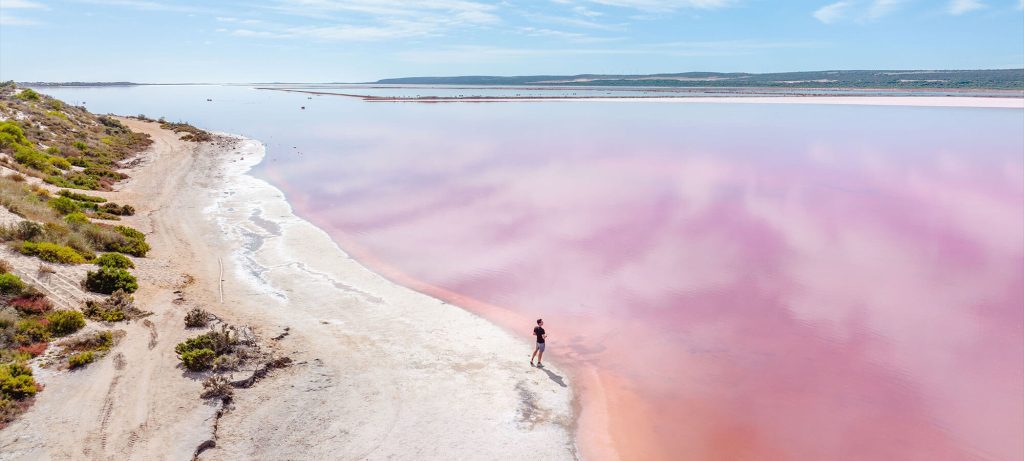
In the heart of the vast down under territory, between arid outback and crystalline waters, lie some uncommon natural treasures: the pink lakes of Australia. These chromatic wonders range from pale pink to deep magenta, creating a striking spectacle. Yet, despite their vibrant presence, they remain largely unknown to the general public.
Discover in this article the main pink lakes scattered throughout the country and add them to your itinerary!
While most lakes in the world get their color from microorganisms like algae, pink lakes have a distinctly different combination. Their particular hue comes from microalgae called Dunaliella salina as well as halophilic bacteria and carotenoid pigments. These microorganisms thrive in specific environmental conditions: high salinity, intense sunlight, and high temperatures.
But this “bubblegum pink” pigmentation isn’t always guaranteed. Indeed, it changes depending on the seasons, cloud cover, salinity levels, and time of day. The spectacle remains equally fascinating because at any time, it offers new colorful nuances.
Among the most intriguing and famous lakes in Australia lies the mysterious Lake Hillier. It is located on Middle Island in the Recherche Archipelago, in Western Australia. Surrounded by dense vegetation and bordered by white sand dunes, the contrast with its bubblegum pink waters is striking.
What makes Lake Hillier even more astonishing is its stable color. Unlike many tinted lakes around the world, its pink hue remains constant throughout the year. This unique characteristic, discovered in 1802 and unchanged since then, fascinates both scientists and visitors alike.
One of the best ways to discover this natural phenomenon is by gaining altitude. Several companies offer panoramic plane tours departing from Esperance. Alternatively, you can also explore Lake Hillier by taking a boat excursion.
Still in the state of Western Australia lies the pink lake of Hutt Lagoon. This 70 km² lagoon is located about a 6-hour drive from Perth, between Port Gregory and Kalbarr.
From bright pink to soft lilac, even raspberry red, the waters of the lake offer a sumptuous sight. To capture its most vibrant hue, it is recommended to visit between 10 am and 2 pm, although the color change can also be surprising before sunset.
You can access the lake by car, especially during the summer. However, be warned: it is advisable to avoid crossing the dried-out parts as the ground remains quite sticky and may trap your vehicle.
For an aerial perspective, several scenic flight companies offer excursions departing from Geraldton and Kalbarri. Expect to pay around 250 dollars for 45 minutes to 1 hour of flight, depending on your departure location.
Finally, near the lake, you will find the fishing village of Port Gregory. It offers basic amenities as well as accommodation options to continue your exploration of the area.
There are also very useful apps for finding campsites and places to spend the night!
Lake Eyre is Australia’s largest salt lake with an impressive area of 9,300 km². It is located in the deserts of central Australia, a six-hour drive from Adelaide.
Usually dry, the lake presents a vast expanse of shimmering salt as far as the eye can see. Its immensity is striking, as are its white and bluish hues. During seasons of heavy rains, the landscape undergoes a radical transformation. Lake Eyre then takes on hues ranging from orangish pink to turquoise blue, even ochre. This natural metamorphosis is accompanied by flourishing greenery and attracts a multitude of fish and birds.
The spectacle is most often admired from the sky. Flights are organized from the nearby towns of Marree and William Creek.
If you’re traveling by car, these two towns offer dining and accommodation options. However, note that a four-wheel-drive vehicle is preferable, especially if you plan to venture to the water’s edge.
Lake Bumbunga is the most accessible of Australia’s pink lakes. If you’re on vacation in Adelaide, it’s less than a two-hour drive away, perfect for a day trip.
The small town of Lochiel and its lake have an unexpected surprise for visitors. A local legend tells of the existence of a creature resembling a giant eel lurking in the depths of Bumbunga Lake. Nicknamed “Loch-Eel” or “Lochie” by the locals, this monster is actually just an imposing statue four meters high and ten meters long.
This artwork was created by a talented mechanic named Wayne Dennis as part of a lake redevelopment program to enhance the region’s tourist appeal. It’s definitely worth a look!
Lake Bumbunga is accessible by car, and ample free parking is available near the observation platform. If you’re staying in the area for several days, don’t miss the opportunity to visit the vineyards of the Clare Valley, less than a 40-minute drive away.
Lake MacDonnell is one of the pinkest lakes in the country. It is located approximately 800km from Adelaide on the Eyre Peninsula in South Australia. For a unique visual contrast, it is recommended to take Watermelon Avenue. The road splits the waters in two: on one side, the lake displays a fuchsia hue, while on the other, you find the green-blue of the ocean.
Swimming is not recommended due to the low water level, but you can still enjoy the nearby beaches. There is notably the beautiful Cactus Beach, known for its dazzling white sand. For those looking to extend their stay, the small town of Penong offers several accommodation options.
Lake Hart, located approximately 6 hours drive from Adelaide and 4 hours from Port Pirie, offers a unique experience in the heart of the Australian outback. Nestled in remote lands, it has two changing faces as the hours pass.
During the day, its waters take on a delicate pink hue, but as night falls, they transform into a deep purple. The isolation of this place provides the opportunity to admire breathtaking starry skies, far from any light pollution.
As the location is quite remote, you can camp by the water even though there are no facilities provided for this purpose. Parking is free. For those without camping gear, consider seeking accommodation nearby. Additionally, you can catch a glimpse of Lake Hart aboard the Indian Pacific Railway, a train journey between Sydney and Perth.
Article written by Manon from Goldenturtles.fr
Ne manquez plus les meilleures opportunités de road trip avec Vanz Travel ! Abonnez-vous pour recevoir bons plans et conseils pratiques pour vos aventures en van.

Looking for the perfect van for your next adventure? Look no further than Vanz Travel! We offer an extensive range of campervan rentals in Australia and New Zealand, ensuring that you’ll find the ideal vehicle to suit your needs and budget.
Copyright Vanz Travel Pty Ltd, all rights reserved.